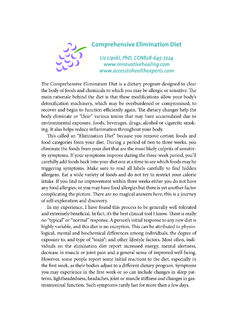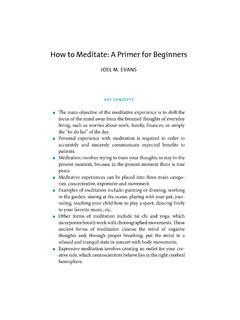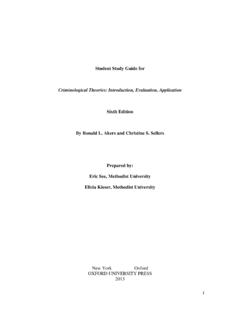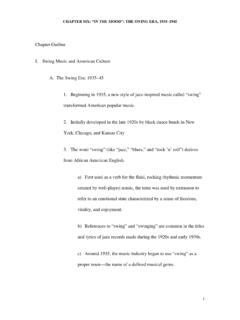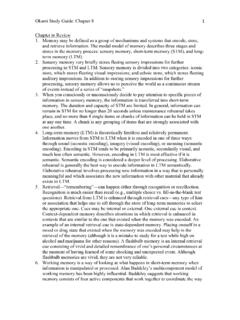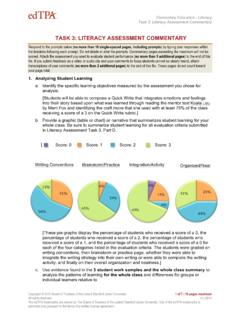Transcription of Task Analyses: Examples and Teaching Suggestions
1 Task analyses : Examples and Teaching Suggestions The procedure of task analysis appears in some of the early psychological literature, particularly that of industrial psychologists who developed a method of task analysis to identify hazards associated with any given job. There are many different definitions of task analysis, but the essentials are the same: t ask analysis is a method to identify the hierarchical order of all essential components in a task. Begin with a clear statement of the goal, which may include context such as the place where the task occurs or other people present.
2 Identify equipment, materials, other essentials, and minimum prerequisites needed to complete each step. Then list all of the essential component steps in order, beginning with an action verb each time. Below are Examples for familiar nonmusic behaviors and ideas for Teaching from a task analysis. Task analyses may be necessary as you develop in-depth analyses of activities for students as described in chapter 4. (See in-depth assessments of activities for Examples of task analyses for music behaviors.) Examples of Task analyses example 1.
3 Hand washing Materials: Sink with running water; faucet with two handles that operate by pulling forward to turn on and pushing back to turn off (cold on left, hot on right); bar of soap; cloth towel. Context: Standing or seated in front of the sink; water is off; bar of soap is on the counter to the right; towel is on a bar to the left. Minimum prerequisite knowledge and skill: For safety, knowledge of cold and hot handles (can be color-coded as needed; some universal design handles have red identifying marks for hot water); direction to move handles to control water flow; use of hands (or adaptive device) to operate handles, pick up soap, and remove and return towel to bar.
4 Steps: 1. Pull left cold water handle with left hand until handle or knob is midway. 2. Pull right hot water handle with right hand one-quarter of the way; keep right hand on handle to complete step 3. 3. Put left hand under running water. 4. Adjust temperature of running water with right handle while left hand stays under water until temperature is warm. 5. Pick up bar of soap with either hand. 6. Holding soap with both hands, put hands under water. 7. Remove hands holding soap. 8. Turn soap in hands several times.
5 9. Put soap back on counter. 10. Continue to rub soapy hands together, front and back, for a count of 10 (pace count by seconds, or sing a favorite song once or twice to last this long). 11. Put hands under running water and continue to rub for a count of 10. 12. Shake hands in sink. 13. Turn off water using either hand. 14. Remove towel with either hand and dry hands. 15. Hang towel back on towel bar. example 2. Tying shoes Context: Seated, with both untied shoes on feet; laces are appropriately tight except that tops of laces hang correspondingly to left and right sides of shoe.
6 Prerequisite knowledge and skill: Fine motor skills using fingers. (Not necessary to know right or left when model is used.) Steps: 1. Take one lace in each hand (laces in corresponding hands). 2. Cross laces to form an X with left lace over right (lace tops point left and right). 3. Pull right lace under left, and bring back to position with lace tops pointing left and right. 4. Hold left and right lace tops in corresponding hands and pull laces tops away from each other until tight lace is tight on foot. 5. Continuing holding laces in corresponding hands.
7 6. Make a large loop with left lace using left hand; loop should have a stem at the bottom. 7. Pinch loop tight using thumb and index finger. 8. Bring right loop toward you and around thumb, index finger, and loop, keeping lace tight around index finger and forming a small hole at bottom of loop. 9. Leaving left thumb as is, reach through hole with index finger of left hand while pushing part of right lace closest to loop into but not through hole. 10. Hold lace in hole with left thumb and index finger and reach up and grasp loop with right thumb and index finger.
8 11. Holding lace in hole with left thumb and finger and holding loop with right thumb and finger, pull loops away from each other. Teaching from a Task Analysis A task analysis is simply a list of logically ordered component behaviors in any given task mini-goals, if you will. The list can provide teachers with a good starting point to determine which particular steps are more complex and need to be learned and which can be learned more easily or are already in the student s repertoire (in the Examples above, perhaps put hands under water and take one lace in each hand ).
9 A task analysis can even show how students can partially participate in performing the task. For example , students with multiple disabilities may not physically be able to complete all of the steps required to wash their hands but may be able to do a few as independently as possible ( , pulling the towel from the towel bar). The important goal for teachers is to find those activities that students can do, teach what they can learn, and provide appropriate adaptations as needed. As in implementing any Teaching strategy, teachers need to incorporate well-established principles of Teaching with each step, such as clear directives, repetition, and feedback.
10 Modeling and prompting (full and partial) are important, a s is the fading of prompts for independence. Although there is a necessary order for some steps (putting on toothpaste before brushing), some steps can be taught out of order or in a different order. Repetition of steps and routines in order, however, is important for many children, and performing one step can cue in the next step in the sequence ( , first we do this, then this, then this). Depending on the task and the student, teachers will need to decide whether it is important for the child to learn (independently perform) steps from the last step forward, to learn from the first step to the end, or to learn various steps throughout the sequence before putting it all together.
